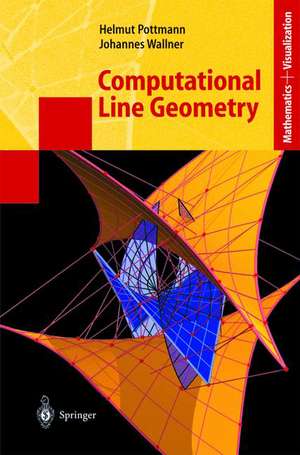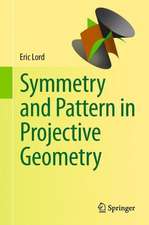Computational Line Geometry: Mathematics and Visualization
Autor Helmut Pottmann, Johannes Wallneren Limba Engleză Hardback – 20 iun 2001
| Toate formatele și edițiile | Preț | Express |
|---|---|---|
| Paperback (1) | 1235.88 lei 6-8 săpt. | |
| Springer Berlin, Heidelberg – 9 feb 2010 | 1235.88 lei 6-8 săpt. | |
| Hardback (1) | 1236.38 lei 6-8 săpt. | |
| Springer Berlin, Heidelberg – 20 iun 2001 | 1236.38 lei 6-8 săpt. |
Din seria Mathematics and Visualization
- 20%
 Preț: 935.20 lei
Preț: 935.20 lei - 18%
 Preț: 960.93 lei
Preț: 960.93 lei - 18%
 Preț: 1110.41 lei
Preț: 1110.41 lei - 20%
 Preț: 994.26 lei
Preț: 994.26 lei - 18%
 Preț: 1220.57 lei
Preț: 1220.57 lei - 18%
 Preț: 958.38 lei
Preț: 958.38 lei - 15%
 Preț: 654.62 lei
Preț: 654.62 lei - 20%
 Preț: 997.38 lei
Preț: 997.38 lei - 15%
 Preț: 645.47 lei
Preț: 645.47 lei - 5%
 Preț: 1101.58 lei
Preț: 1101.58 lei - 20%
 Preț: 992.44 lei
Preț: 992.44 lei - 20%
 Preț: 1284.47 lei
Preț: 1284.47 lei - 20%
 Preț: 656.69 lei
Preț: 656.69 lei - 20%
 Preț: 476.68 lei
Preț: 476.68 lei - 20%
 Preț: 1273.08 lei
Preț: 1273.08 lei - 15%
 Preț: 649.54 lei
Preț: 649.54 lei - 20%
 Preț: 335.36 lei
Preț: 335.36 lei - 20%
 Preț: 646.95 lei
Preț: 646.95 lei - 20%
 Preț: 651.75 lei
Preț: 651.75 lei - 20%
 Preț: 657.99 lei
Preț: 657.99 lei - 18%
 Preț: 1223.74 lei
Preț: 1223.74 lei - 20%
 Preț: 333.72 lei
Preț: 333.72 lei - 20%
 Preț: 709.98 lei
Preț: 709.98 lei - 20%
 Preț: 992.26 lei
Preț: 992.26 lei - 20%
 Preț: 648.44 lei
Preț: 648.44 lei - 20%
 Preț: 1158.59 lei
Preț: 1158.59 lei - 20%
 Preț: 330.66 lei
Preț: 330.66 lei - 18%
 Preț: 963.91 lei
Preț: 963.91 lei - 15%
 Preț: 653.98 lei
Preț: 653.98 lei - 20%
 Preț: 991.94 lei
Preț: 991.94 lei - 18%
 Preț: 958.07 lei
Preț: 958.07 lei
Preț: 1236.38 lei
Preț vechi: 1507.77 lei
-18% Nou
Puncte Express: 1855
Preț estimativ în valută:
236.58€ • 247.67$ • 195.75£
236.58€ • 247.67$ • 195.75£
Carte tipărită la comandă
Livrare economică 05-19 aprilie
Preluare comenzi: 021 569.72.76
Specificații
ISBN-13: 9783540420583
ISBN-10: 3540420584
Pagini: 576
Ilustrații: X, 564 p. 264 illus., 17 illus. in color.
Dimensiuni: 155 x 235 x 41 mm
Greutate: 0.98 kg
Ediția:2001
Editura: Springer Berlin, Heidelberg
Colecția Springer
Seria Mathematics and Visualization
Locul publicării:Berlin, Heidelberg, Germany
ISBN-10: 3540420584
Pagini: 576
Ilustrații: X, 564 p. 264 illus., 17 illus. in color.
Dimensiuni: 155 x 235 x 41 mm
Greutate: 0.98 kg
Ediția:2001
Editura: Springer Berlin, Heidelberg
Colecția Springer
Seria Mathematics and Visualization
Locul publicării:Berlin, Heidelberg, Germany
Public țintă
ResearchCuprins
Fundamentals.- Models of Line Space.- Linear Complexes.- Approximation in Line Space.- Ruled Surfaces.- Developable Surfaces.- Line Congruences and Line Complexes.- Linear Line Mappings #x2014; Computational Kinematics.
Recenzii
From the reviews of the first edition:
"... The depth of the presentation is one of the striking things about this work. It does not only scratch the surface of the numerous fields but delves into the matter meticulously. But all the same there is enough room left for applications which keep the book exciting, not only for students and mathematicians but also for ambitious engineers. ... I can well imagine that this book will render a tremendous service to many of its readers. I wholeheartedly recommend this outstanding monograph."
J.Lang (Graz), IMN - Internationale Mathematische Nachrichten 190, 2002, pp. 65-66
"...There is a vast amount of fascinating geometry of all sorts in this book. The topics are perhaps somewhat eclectic - they mirror the primary interests of the authors - but, because the motivation is to develop the geometry that applies to real world problems, the subject is far from monolithic and is open to interpretation. The ideas here build up layer upon layer. In the end, the authors have been mostly successful in sustaining their central theme, despite the need to weave together projective, differential, algebraic and metric geometry. They have also presented the mathematics in a predominantly modern way. That is important because there exist in the engineering literature archaelogical remnants of outdated notation and concepts. [....] The large number (264) of line diagrams are of very good quality and considerably enhance one's understanding. [...] a book which is without doubt an important contribution to this growing branch of geometrical research."
P. Donelan (Wellington) - New Zealand Matheamtical Society Newsletter 87, April 2003.
"The authors have combined results from the classical parts of geometry with computational methods. This results in a unique and fascinating blend, which is shown to be useful for a variety of applications, includingrobotics, geometrical optics, computer animation, and geometric design. The contents of the book are visualized by a wealth of carefully chosen illustrations, making the book a sheer pleasure to read, or even just browse in. The book will help to bring the concepts and techniques of line geometry, which have been shown to be useful for various applications in geometric design and engineering, to the attention of a wider audience."—MATHEMATICAL REVIEWS
"The didactically well-considered and marvelously illustrated book is self-contained at least for readers acquainted with basic concepts of (classical) differential geometry and CAGD, and, of course, with (advanced) linear algebra and some calculus. The reader of this demanding textbook is richly rewarded by applicable knowledge, and he surely will enjoy the elegance of geometric reasoning and the effectiveness of line-geometric calculations."
(Gunter Weiß, Zentralblatt MATH, Vol. 1006, 2003)
"... In der Einleitung schreiben die Autoren, dass ihnen von verschiedenen Kollegen naheglegt wurde, ein Buch über "klassische" Geometrie und deren Anwendung auf geometrisches Rechnen zu schreiben. Da ihnen diese Aufgabe als zu umfangreich erschien, haben sie sich hier auf die Geraden-Geometrie beschränkt. Sie haben damit eine sehr glückliche Wahl getroffen: Einserseits ist diese Darstellung thematisch einheitlich und geschlossen, andererseits wird eine schier unglaubliche Fülle von Material detailliert beschrieben. ... Das Buch enthält 237 sehr informative und sorgfältig ausgeführte Illustrationen und 17 Farbtafeln. Damit ist das Buch auch ästhetisch sehr beeindruckend. Das Buch wird wohl ein Standard-Werk für die sogenannte "Angewandte Geometrie" werden, eine Weiterentwicklung der traditionellen Ingenieurs-Geometrie mit modernsten Methoden."
W.Barth (Erlangen), Jahresbericht der DMV 105, Band (2003), Heft 2
"... The depth of the presentation is one of the striking things about this work. It does not only scratch the surface of the numerous fields but delves into the matter meticulously. But all the same there is enough room left for applications which keep the book exciting, not only for students and mathematicians but also for ambitious engineers. ... I can well imagine that this book will render a tremendous service to many of its readers. I wholeheartedly recommend this outstanding monograph."
J.Lang (Graz), IMN - Internationale Mathematische Nachrichten 190, 2002, pp. 65-66
"...There is a vast amount of fascinating geometry of all sorts in this book. The topics are perhaps somewhat eclectic - they mirror the primary interests of the authors - but, because the motivation is to develop the geometry that applies to real world problems, the subject is far from monolithic and is open to interpretation. The ideas here build up layer upon layer. In the end, the authors have been mostly successful in sustaining their central theme, despite the need to weave together projective, differential, algebraic and metric geometry. They have also presented the mathematics in a predominantly modern way. That is important because there exist in the engineering literature archaelogical remnants of outdated notation and concepts. [....] The large number (264) of line diagrams are of very good quality and considerably enhance one's understanding. [...] a book which is without doubt an important contribution to this growing branch of geometrical research."
P. Donelan (Wellington) - New Zealand Matheamtical Society Newsletter 87, April 2003.
"The authors have combined results from the classical parts of geometry with computational methods. This results in a unique and fascinating blend, which is shown to be useful for a variety of applications, includingrobotics, geometrical optics, computer animation, and geometric design. The contents of the book are visualized by a wealth of carefully chosen illustrations, making the book a sheer pleasure to read, or even just browse in. The book will help to bring the concepts and techniques of line geometry, which have been shown to be useful for various applications in geometric design and engineering, to the attention of a wider audience."—MATHEMATICAL REVIEWS
"The didactically well-considered and marvelously illustrated book is self-contained at least for readers acquainted with basic concepts of (classical) differential geometry and CAGD, and, of course, with (advanced) linear algebra and some calculus. The reader of this demanding textbook is richly rewarded by applicable knowledge, and he surely will enjoy the elegance of geometric reasoning and the effectiveness of line-geometric calculations."
(Gunter Weiß, Zentralblatt MATH, Vol. 1006, 2003)
"... In der Einleitung schreiben die Autoren, dass ihnen von verschiedenen Kollegen naheglegt wurde, ein Buch über "klassische" Geometrie und deren Anwendung auf geometrisches Rechnen zu schreiben. Da ihnen diese Aufgabe als zu umfangreich erschien, haben sie sich hier auf die Geraden-Geometrie beschränkt. Sie haben damit eine sehr glückliche Wahl getroffen: Einserseits ist diese Darstellung thematisch einheitlich und geschlossen, andererseits wird eine schier unglaubliche Fülle von Material detailliert beschrieben. ... Das Buch enthält 237 sehr informative und sorgfältig ausgeführte Illustrationen und 17 Farbtafeln. Damit ist das Buch auch ästhetisch sehr beeindruckend. Das Buch wird wohl ein Standard-Werk für die sogenannte "Angewandte Geometrie" werden, eine Weiterentwicklung der traditionellen Ingenieurs-Geometrie mit modernsten Methoden."
W.Barth (Erlangen), Jahresbericht der DMV 105, Band (2003), Heft 2
Textul de pe ultima copertă
The geometry of lines occurs naturally in such different areas as sculptured surface machining, computation of offsets and medial axes, surface reconstruction for reverse engineering, geometrical optics, kinematics and motion design, and modeling of developable surfaces. This book covers line geometry from various viewpoints and aims towards computation and visualization. Besides applications, it contains a tutorial on projective geometry and an introduction into the theory of smooth and algebraic manifolds of lines. It will be useful to researchers, graduate students, and anyone interested either in the theory or in computational aspects in general, or in applications in particular.
From the reviews :
"The authors have combined results from the classical parts of geometry with computational methods. This results in a unique and fascinating blend, which is shown to be useful for a variety of applications, including robotics, geometrical optics, computer animation, and geometric design. The contents of the book are visualized by a wealth of carefully chosen illustrations, making the book a sheer pleasure to read, or even just browse in. The book will help to bring the concepts and techniques of line geometry, which have been shown to be useful for various applications in geometric design and engineering, to the attention of a wider audience."
B.Jüttler, MATHEMATICAL REVIEWS Clippings 2002f
"...There is a vast amount of fascinating geometry of all sorts in this book. The topics are perhaps somewhat eclectic - they mirror the primary interests of the authors - but, because the motivation is to develop the geometry that applies to real world problems, the subject is far from monolithic and is open to interpretation. The ideas here build up layer upon layer. In the end, the authors have been mostly successful in sustaining their central theme, despite the need to weave together projective, differential, algebraicand metric geometry. They have also presented the mathematics in a predominantly modern way. That is important because there exist in the engineering literature archaeological remnants of outdated notation and concepts. [....] The large number (264) of line diagrams are of very good quality and considerably enhance one's understanding. [...] a book which is without doubt an important contribution to this growing branch of geometrical research."
P. Donelan - New Zealand Mathematical Society Newsletter 87, 2003
"… Overall I recommend this text to anyone who wants to learn about line geometry, projective geometry and the geometric side of some algebra. The book fills a niche that has been neglected for long and should benefit researchers interested in geometric methods. … It covers a body of knowledge that is underrepresented in the literature and deserves to be known more widely. The authors wrote a clearly developed and beautifully illustrated book that fills a gaping hole in the contemporary literature."
ACM SIGACT News 36:3, 2005
From the reviews :
"The authors have combined results from the classical parts of geometry with computational methods. This results in a unique and fascinating blend, which is shown to be useful for a variety of applications, including robotics, geometrical optics, computer animation, and geometric design. The contents of the book are visualized by a wealth of carefully chosen illustrations, making the book a sheer pleasure to read, or even just browse in. The book will help to bring the concepts and techniques of line geometry, which have been shown to be useful for various applications in geometric design and engineering, to the attention of a wider audience."
B.Jüttler, MATHEMATICAL REVIEWS Clippings 2002f
"...There is a vast amount of fascinating geometry of all sorts in this book. The topics are perhaps somewhat eclectic - they mirror the primary interests of the authors - but, because the motivation is to develop the geometry that applies to real world problems, the subject is far from monolithic and is open to interpretation. The ideas here build up layer upon layer. In the end, the authors have been mostly successful in sustaining their central theme, despite the need to weave together projective, differential, algebraicand metric geometry. They have also presented the mathematics in a predominantly modern way. That is important because there exist in the engineering literature archaeological remnants of outdated notation and concepts. [....] The large number (264) of line diagrams are of very good quality and considerably enhance one's understanding. [...] a book which is without doubt an important contribution to this growing branch of geometrical research."
P. Donelan - New Zealand Mathematical Society Newsletter 87, 2003
"… Overall I recommend this text to anyone who wants to learn about line geometry, projective geometry and the geometric side of some algebra. The book fills a niche that has been neglected for long and should benefit researchers interested in geometric methods. … It covers a body of knowledge that is underrepresented in the literature and deserves to be known more widely. The authors wrote a clearly developed and beautifully illustrated book that fills a gaping hole in the contemporary literature."
ACM SIGACT News 36:3, 2005
Caracteristici
This book for the first time studies line geometry from the viewpoint of scientific computation and shows the interplay between theory and numerous applications Includes supplementary material: sn.pub/extras




















